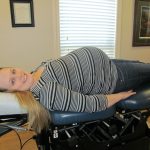16 Aug 2017
How Chiropractic Helps with Pregnancy
How Chiropractic Helps with Pregnancy
For a uncomplicated pregnancy our protocol involves discussing the medical history, habits, hobbies, daily routine and activity level of the patient. First of all not all pregnancies are the same, while some ladies have a easy pregnancy, others may have symptoms early on. Also, as the pregnancy progresses the biomechanics of the body changes greatly. The center of gravity changes, increased lumbar lordosis (curvature) and as weight increases they begin to have hip pain and pelvic pain. One of the initial observations we make is about the leg length, uneven pelvic height, pelvic tilt, rounded shoulders, head forward posture, uneven shoulder height. We look for asymmetry in muscle tone from front to back (quads vs hamstrings) and the paraspinal soft tissues from the right side to the left side of the Cervicals, Thoracic and Lumbars. These muscles include: Supra Spinatus, Levator Scapula, Rhomboids, Infra-Spinatus, Erector Spinae, Psoas/Iliopsoas, Gluteal Minimus/Medius and Quadratus Lumborum. Since muscles are the only contractile tissues that move our bones, our joints tend to move toward the side that is pulling harder on it. One example of this would be: A taut left Quad and a taut right hamstring. This would cause a torque of the pelvis in a uneven manner and can cause one leg to appear slightly shorter than the other side. These are a few of the things we evaluate during the initial examination. One of the most important part of this exam is to make the patient aware of the alterations that we observe.
Evaluation of the spine, hips, shoulders, ankles during pregnancy changes with the phase of pregnancy. This is because the change in weight, flexibility, water retention and hormones. One of the hormones that has a major affect is the Relaxin hormone. This hormone is in it’s highest concentration during the 1st trimester. This hormone helps prevent contractions, relax the ligaments at the anterior pelvis to ease delivery.
The pelvic canal is the boney structure that surrounds the birth canal from which the baby will pass through. This is made up of the pubic bone in the front and the ischium on each side. The two sacroiliac joints are in the back between the sacrum and ischium, while the pubic symphysis is the joint in the front. These joints must flex to open up the birth canal. Chiropractic helps this process by gently mobilizing these joints through passive stretches and motioning these joints. Normally these joints are only slightly flexible.
Another musculoskeletal alteration common during pregnancy is posture while sitting and standing. During the later stages of pregnancy most women have to sit with their legs further apart due to the extension of their belly. Over time this causes the gluts and hip external rotators to shorten. This is observed during gait with the feet pointing outward and during motion palpation and reduced passive range of motion of hip adduction. Chiropractic physiotherapies work to increase the range of motion of the hips, posterior pelvic and lateral thigh soft tissues. We show specific pelvic, hip and lumbar stretches to be done at home to their tolerance. These therapies are very effective when began early in the pregnancy.
The lumbar spine becomes compressed and increases in curvature that adds even more compression. Spinal adjustments during pregnancy are very safe and effective. This helps even leg length, mobility, and reduces discomfort greatly. The treatment protocol during pregnancy incorporates soft tissues and their joints. There is much more involved in treating ladies during their pregnancy but this article is written to address a few of the finer points of Chiropractic care during pregnancy.~ Dr. Clay Gross Grace Chiropractic Center.


No Comments